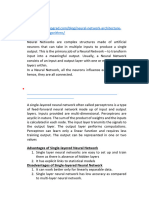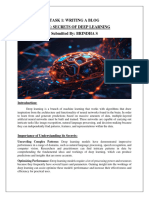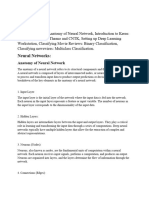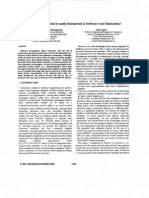0 ratings0% found this document useful (0 votes)
26 viewsUniversity of Computer Studies, Mandalay (UCSM)
University of Computer Studies, Mandalay (UCSM)
Uploaded by
Hsu Let Yee HninThis document discusses different approaches to integrating heterogeneous sources of partial domain knowledge into machine learning systems. It describes embedding prior knowledge from expert systems into neural networks in two ways: 1) converting the expert system rules into a corresponding neural network and then extending it with learning, and 2) directly embedding the expert system into a neural network during construction. The hybrid approach combines the symbolic knowledge representation of expert systems with the learning ability of neural networks.
Copyright:
© All Rights Reserved
Available Formats
Download as PPTX, PDF, TXT or read online from Scribd
University of Computer Studies, Mandalay (UCSM)
University of Computer Studies, Mandalay (UCSM)
Uploaded by
Hsu Let Yee Hnin0 ratings0% found this document useful (0 votes)
26 views23 pagesThis document discusses different approaches to integrating heterogeneous sources of partial domain knowledge into machine learning systems. It describes embedding prior knowledge from expert systems into neural networks in two ways: 1) converting the expert system rules into a corresponding neural network and then extending it with learning, and 2) directly embedding the expert system into a neural network during construction. The hybrid approach combines the symbolic knowledge representation of expert systems with the learning ability of neural networks.
Original Title
Chapter 7
Copyright
© © All Rights Reserved
Available Formats
PPTX, PDF, TXT or read online from Scribd
Share this document
Did you find this document useful?
Is this content inappropriate?
This document discusses different approaches to integrating heterogeneous sources of partial domain knowledge into machine learning systems. It describes embedding prior knowledge from expert systems into neural networks in two ways: 1) converting the expert system rules into a corresponding neural network and then extending it with learning, and 2) directly embedding the expert system into a neural network during construction. The hybrid approach combines the symbolic knowledge representation of expert systems with the learning ability of neural networks.
Copyright:
© All Rights Reserved
Available Formats
Download as PPTX, PDF, TXT or read online from Scribd
Download as pptx, pdf, or txt
0 ratings0% found this document useful (0 votes)
26 views23 pagesUniversity of Computer Studies, Mandalay (UCSM)
University of Computer Studies, Mandalay (UCSM)
Uploaded by
Hsu Let Yee HninThis document discusses different approaches to integrating heterogeneous sources of partial domain knowledge into machine learning systems. It describes embedding prior knowledge from expert systems into neural networks in two ways: 1) converting the expert system rules into a corresponding neural network and then extending it with learning, and 2) directly embedding the expert system into a neural network during construction. The hybrid approach combines the symbolic knowledge representation of expert systems with the learning ability of neural networks.
Copyright:
© All Rights Reserved
Available Formats
Download as PPTX, PDF, TXT or read online from Scribd
Download as pptx, pdf, or txt
You are on page 1of 23
University of Computer Studies, Mandalay
(UCSM)
Faculty of Computer Science
Chapter 7 Integration of Heterogeneous
Sources of Partial Domain Knowledge
A domain transforming neural network model that starts
from a single source of prior- knowledge and grows
incrementally as needed is introduced next.
In this model two integration techniques are explored:
(1) converting the expert system rule base into a corresponding
neural network and then extending this network by constructive
learning; and
(2) embedding the pre-existing expert system directly into a
constructive neural network learning system.
Introduction
Automatically classifying data into categories is an
important problem in many real life domains.
There are two traditional ways for a computer system to
acquire knowledge required to perform classification
tasks.
The knowledge based approach translates information obtained
from human domain experts into a form that is interpretable by a
computer system. This knowledge base is the core of an expert
system, which emulates human decision-making skills.
The alternative approach, called machine learning, is an attempt to
extract knowledge directly from data.
Cont’d
Each of these two approaches has its advantages and
disadvantages.
An expert system represents knowledge in symbolic
form allowing relatively easy manipulation and
incorporation of newly obtained knowledge.
A machine learning system is less dependent on human
understanding of the phenomena and can, in principle,
be applied to any domain with sufficient amount of
available data.
Cont’d
Expert systems assume human understanding of the
phenomena and availability of an expert capable of explaining
domain knowledge to a computer programmer. The
knowledge used to build an expert system is typically
acquired from the expertise of many individuals and thus, it
can be inconsistent and incomplete.
Similarly, a data set used to build a machine learning system
can be noisy, conflicting and sparse. Even if these problems
are not present in a given data set, extracting complex
nonlinear relationships directly from data through machine
learning can still be a difficult nonlinear optimization task.
Cont’d
Hybrid intelligent systems that integrate knowledge
extraction from data and the use of existing alternative
sources of domain specific knowledge have had
considerable practical success.
Cont’d
the most popular approaches for integrating multiple
learning components are:
(1) combining expert modules through various averaging scenarios;
and
(2) selecting the most competent local expert for any given example.
The combining approach can potentially be used to
reduce the variance of an unstable predictor without
increasing its bias.
Cont’d
Neural network machine learning techniques are
combined with expert systems in order to complement
and enhance their capabilities. This combination has
been carried out in several directions including:
Transformational models
Loosely-coupled models
Tightly-coupled models
Transformational models
one type of system is transformed into another, i.e. either
an expert system is transformed into a neural network or
vice versa.
Neural nets are transformed into expert systems
whenever knowledge documentation and justification
facilities are needed.
Conversely, an expert system can be transformed into a
neural network when speed, adaptability and robustness
are a priority.
Fully-integrated models
Several systems share data structures and knowledge
representation.
The most common variation of this model is the
connectionist expert system, in which symbolic nodes
are connected by weighted links.
These systems are robust and have improved problem
solving characteristics, but the complexity of the system
makes it difficult to develop and maintain.
Loosely-coupled models
This is an integrational model in which neural network
and knowledge- based systems interact through shared
data files.
These systems are easier to develop than more
integrated models, allowing for the use of commercial
software for both expert systems and neural networks,
but at the cost of slower operation, redundancy in
computational capabilities, overlap in data input
requirements and high communication cost.
Tightly-coupled models
This type of architecture uses independent neural net
and expert systems.
The difference is that here the interaction is by means of
memory resident data structures, so communication and
operation velocities are vastly improved.
System development is not much more difficult than that
for loosely-coupled systems, but redundancy is also an
issue.
Integrate Neural Network Learning
Embedding transformed experts. This is a
transformational approach in which the expert is
converted into a neural network that serves as a starting
point for learning from examples.
Embedding experts directly. In this approach the
experts are embedded without modifications in the
hybrid classification system, which means that no
knowledge of their internal mechanisms is required.
The Hybrid System
Single expert expansion systems. In this approach, all
expert knowledge comes from a single source, which is
further expanded through neural network learning.
Multiple experts integration systems. Here multiple,
possibly heterogeneous, experts are integrated into a
hybrid classification system.
Experts Intégration: Domain or
Range Transformation Dilemma
A classification problem can be viewed as identification
of an appropriate mapping from a given domain to a
range of categories.
Domain Transformation
When using the outputs of several experts as inputs to a
new classifier (called a combiner.), the original input
space is transformed to an entirely new one, its
dimensionality being defined by the number of experts
used and their output representation.
Cont’d
Reduced domain dimensionality. This results in
models with less parameters, which, due to the curse of
dimensionality, can be a significant advantage when
designing a model from a limited data set.
Input preprocessing. The domain transformation can
be regarded as a feature extraction process. This can
help eliminate the effect of irrelevant or noisy input
variables.
Simpler decision regions. Even if the original
dimensionality is not significantly reduced through a
transformation, classes in the new domain may be easier
to separate due to more favorable clustering of the
patterns.
Range Transformation
A classifier is trained to integrate the various experts by
partitioning the domain and assigning disjoint regions to
individual experts.
The original problem domain does not change, but the
integrating classifier has a different class range defined
by the number of experts.
Cont’d
Hybrid systems relying on range transformation can provide various
advantages
over original classifiers, specifically the following:
Simpler decision regions. As in the domain transformation case, it
is anticipated that the transformed problem will have simpler
decision regions than the original one, thus being easier to solve
and requiring a less complex classifier to do
Restricted domain for local training. Assigning a portion of the
domain to a specific classifier allows local training of machine
learning based experts on the remaining region or regions.
Insensibility to output representation. Range transformation
works in the same way regardless of the experts’ output
representation. Indeed, the technique can even work with experts
whose output representations differ from one another.
Incremental Single Expert
Expansion
A knowledge-based artificial neural network approach
called KBANN, that generates neural networks from
hierarchically-structured rules. In these neural networks
units correspond to rules, while connection weights and
thresholds correspond to rule dependencies.
Each layer is then fully connected with the weights of the
new links set to small random values.
Finally, the initial knowledge is refined by neural network
training from examples using the backpropagation
algorithm
The HDE Algorithm
Construction of the HDE neural network is
performed in three phases:
1. Determination of points on the decision boundary;
2. Generation of a pool of candidate hyperplanes from
the obtained points; and
3. Selection of the final separating hyperplanes from the
candidate pool and creation of hidden units from
selected hyperplanes.
Embedding of Transformed Prior
Knowledge
the HDE algorithm is used to add neurons to the
last layer of the initial neural network.
The output weights of the starting network are
modified after each new hidden unit is added
through HDE construction.
Direct Integration of Prior
Knowledge
A hybrid architecture is constructed with the expert
system directly embedded into the neural network
The three-phase process of the HDE algorithm is
followed with certain small exceptions.
An initial network consisting of the input layer, a single hidden unit
and an output unit is created.
The hidden unit is designated as an expert unit, which, instead of
computing the usual activation function, calls the expert system to
determine the unit’s output.
The expert unit, then, acts as the initial hidden unit, contributing with
its decision boundary, such as the simple one.
You might also like
- Components-Algorithms/: The Basic Architecture of Neural Networks: Single Computational LayerDocument65 pagesComponents-Algorithms/: The Basic Architecture of Neural Networks: Single Computational Layerafiyaparveen786No ratings yet
- Room Classification Using Machine LearningDocument16 pagesRoom Classification Using Machine LearningVARSHANo ratings yet
- Deep Fuzzy ModelsDocument3 pagesDeep Fuzzy ModelsSally AbdulazizNo ratings yet
- 2020_BigData_Hybrid_Decision_Tree-Neural_NetworkDocument9 pages2020_BigData_Hybrid_Decision_Tree-Neural_NetworkReroNo ratings yet
- Neural Networks & Deep Learning Makaut & & 7th SemNotesDocument36 pagesNeural Networks & Deep Learning Makaut & & 7th SemNotesdeysatwik093No ratings yet
- SHAI - Task 3 - NNDocument10 pagesSHAI - Task 3 - NNmohmadanasshb21No ratings yet
- Assignment of Cs 5 SemDocument4 pagesAssignment of Cs 5 Semm54mohtashimNo ratings yet
- Unit-4 ML Notes Part-2Document21 pagesUnit-4 ML Notes Part-2Prateek SaxenaNo ratings yet
- SeminarDocument13 pagesSeminaryuli0.0yuli.0No ratings yet
- Complete Deep Learning Interview QuestionDocument46 pagesComplete Deep Learning Interview Questionkdiwakarreddy1710No ratings yet
- Information Management AssignmentDocument33 pagesInformation Management Assignmentjbleander2021No ratings yet
- Machine Learning Unit 3-5Document13 pagesMachine Learning Unit 3-5sugeelgundoo121No ratings yet
- Deep Learning As A Frontier of Machine Learning ADocument10 pagesDeep Learning As A Frontier of Machine Learning ARafi Y.SNo ratings yet
- Akay 2021Document66 pagesAkay 2021Ozturk bNo ratings yet
- Lyu 2019Document8 pagesLyu 2019vchicavNo ratings yet
- DOC-20241117-WA0000Document52 pagesDOC-20241117-WA0000Jesus IncorporationNo ratings yet
- Master Thesis Neural NetworkDocument4 pagesMaster Thesis Neural Networktonichristensenaurora100% (1)
- Secrets of Deep Learning 1716536527Document12 pagesSecrets of Deep Learning 1716536527shantyyyy23No ratings yet
- Deep Learning Review and Discussion of Its Future PDFDocument7 pagesDeep Learning Review and Discussion of Its Future PDFeswarannihilNo ratings yet
- Data Science Project Training ReportDocument19 pagesData Science Project Training ReportSunny SharanNo ratings yet
- Introduction To Deep LearningDocument11 pagesIntroduction To Deep Learningatharva9arvinNo ratings yet
- Literature SurveyDocument12 pagesLiterature SurveyWebhub TechnologyNo ratings yet
- Principles of Convolutional Neural NetworksDocument9 pagesPrinciples of Convolutional Neural NetworksAsma AliNo ratings yet
- Basic of Machine LearningDocument7 pagesBasic of Machine LearningDivyanshi DubeyNo ratings yet
- DLunit 3Document13 pagesDLunit 3EXAMCELL - H4No ratings yet
- AI UNIT 4 Lecture 2Document7 pagesAI UNIT 4 Lecture 2Sunil NagarNo ratings yet
- Deep Learning Review and Discussion of Its FutureDocument7 pagesDeep Learning Review and Discussion of Its FutureairsrchNo ratings yet
- 1st Semester MSC 2024Document16 pages1st Semester MSC 2024ajmolNo ratings yet
- Dss On Life InsuranceDocument20 pagesDss On Life InsuranceKirtika SharmaNo ratings yet
- PaperDocument6 pagesPaperZulkifal A ràjaNo ratings yet
- Evolutionary Neural Networks For Product Design TasksDocument11 pagesEvolutionary Neural Networks For Product Design TasksjlolazaNo ratings yet
- A Beginners Guide To The Mathematics of Neural NetworksDocument17 pagesA Beginners Guide To The Mathematics of Neural Networksrhycardo5902No ratings yet
- FED Learning Mini ProjectDocument17 pagesFED Learning Mini Projectharendra8587No ratings yet
- Constructive Neural Networks: A Review: Sudhir Kumar SharmaDocument9 pagesConstructive Neural Networks: A Review: Sudhir Kumar SharmaSilvia Adelina MateescuNo ratings yet
- Ai - Unit 4 - Study ResourceDocument15 pagesAi - Unit 4 - Study ResourceY20me135 V.LokeshNo ratings yet
- 1.convolutional Neural Networks For Image ClassificationDocument11 pages1.convolutional Neural Networks For Image ClassificationMuhammad ShoaibNo ratings yet
- MODULE 2 DLDocument9 pagesMODULE 2 DLlusifer PotterNo ratings yet
- With Morphnet, Google Helps You Build Faster and Smaller Neural NetworksDocument6 pagesWith Morphnet, Google Helps You Build Faster and Smaller Neural NetworksPeterNo ratings yet
- Deep Learning As A Frontier of Machine Learning ADocument10 pagesDeep Learning As A Frontier of Machine Learning AAvinash KattaNo ratings yet
- Cluster Computing in Large Scale SimulationDocument9 pagesCluster Computing in Large Scale SimulationKinjalkumar M. GarasiyaNo ratings yet
- Unit 2Document64 pagesUnit 2dengduchupaaNo ratings yet
- “Transfer Learning” for Bridging the Gap Between Data Sciences and the Deep LearningDocument9 pages“Transfer Learning” for Bridging the Gap Between Data Sciences and the Deep Learningelectro-ub ubNo ratings yet
- Can Neural Networks Be Easily Interpreted in Software Cost Estimation?Document6 pagesCan Neural Networks Be Easily Interpreted in Software Cost Estimation?jagannath_singhNo ratings yet
- Deep Feed-Forward Neural NetworkDocument4 pagesDeep Feed-Forward Neural NetworkAnkit MahapatraNo ratings yet
- Survey SummaryDocument8 pagesSurvey SummaryK VENKATA SRAVANINo ratings yet
- Deep LearningDocument8 pagesDeep Learninganiketnar8No ratings yet
- Assignment 5 AiDocument3 pagesAssignment 5 AiPiyush BhandariNo ratings yet
- 12 ASAP TimeSeriesForcasting - Neural Networks - Day 12-15Document49 pages12 ASAP TimeSeriesForcasting - Neural Networks - Day 12-15George MathewNo ratings yet
- 2017 - Privacy-PreservingDocument20 pages2017 - Privacy-Preservingfaheem ismailNo ratings yet
- Deep LearningDocument5 pagesDeep LearningNikyleNo ratings yet
- Deep Learning NotesDocument71 pagesDeep Learning NotesbarakNo ratings yet
- Optimization of Nonlinear Convolutional Neural Networks Based On Improved Chameleon Group AlgorithmDocument8 pagesOptimization of Nonlinear Convolutional Neural Networks Based On Improved Chameleon Group AlgorithmDarshanNo ratings yet
- Neural Networks and Deep Learning: Enhancing Ai Through Neural Network OptimizationDocument5 pagesNeural Networks and Deep Learning: Enhancing Ai Through Neural Network OptimizationIJAR JOURNALNo ratings yet
- SC_04Document21 pagesSC_04paramjeet kaurNo ratings yet
- Deep_Learning_1687744660Document26 pagesDeep_Learning_1687744660GOURAV KUMARNo ratings yet
- Distributed Computing CSC413 NoteDocument45 pagesDistributed Computing CSC413 Notecgzxkf7bhqNo ratings yet
- Neural Networks: A Requirement For Intelligent SystemsDocument10 pagesNeural Networks: A Requirement For Intelligent SystemsANISHNo ratings yet
- 2017 Konecny Et Al Federated Learning Google PaperDocument10 pages2017 Konecny Et Al Federated Learning Google PaperRITHU PRAKASHNo ratings yet
- Fuzzy K-NN & Fuzzy Back PropagationDocument7 pagesFuzzy K-NN & Fuzzy Back PropagationInternational Journal of Application or Innovation in Engineering & ManagementNo ratings yet
- Api OcrDocument60 pagesApi OcrHsu Let Yee HninNo ratings yet
- BIM-FDB-BI Tools QuotationDocument1 pageBIM-FDB-BI Tools QuotationHsu Let Yee HninNo ratings yet
- Huawei Cloud Account RegistrationDocument9 pagesHuawei Cloud Account RegistrationHsu Let Yee HninNo ratings yet
- Without SMOTE - Data - Imputation - LR - D2Document7 pagesWithout SMOTE - Data - Imputation - LR - D2Hsu Let Yee HninNo ratings yet
- Comparisons of Bi Tools: Presented by Hsu LetDocument6 pagesComparisons of Bi Tools: Presented by Hsu LetHsu Let Yee HninNo ratings yet
- Feature Selection: Mean Square Between Groups Mean Square Within GroupsDocument4 pagesFeature Selection: Mean Square Between Groups Mean Square Within GroupsHsu Let Yee HninNo ratings yet
- Chapter 6 - ExercisesDocument5 pagesChapter 6 - ExercisesHsu Let Yee HninNo ratings yet
- SMOTE Samples Calculation: X - Class (Y 1)Document2 pagesSMOTE Samples Calculation: X - Class (Y 1)Hsu Let Yee HninNo ratings yet
- AnswerDocument3 pagesAnswerHsu Let Yee HninNo ratings yet
- Data Imputation With KNN: E (A, B) X X E (A, B) X XDocument2 pagesData Imputation With KNN: E (A, B) X X E (A, B) X XHsu Let Yee HninNo ratings yet
- Logistic: Regression Sigmoid FunctionDocument4 pagesLogistic: Regression Sigmoid FunctionHsu Let Yee HninNo ratings yet
- SMOTE Samples Calculation: X - Class (Y 1)Document2 pagesSMOTE Samples Calculation: X - Class (Y 1)Hsu Let Yee HninNo ratings yet
- University of Computer Studies, Mandalay (UCSM)Document12 pagesUniversity of Computer Studies, Mandalay (UCSM)Hsu Let Yee HninNo ratings yet
- Comparison of Learning Techniques For Prediction of Customer Churn in TelecommunicationDocument36 pagesComparison of Learning Techniques For Prediction of Customer Churn in TelecommunicationHsu Let Yee HninNo ratings yet
- Chapter 2 Digital Image FundamentalsDocument85 pagesChapter 2 Digital Image FundamentalsHsu Let Yee HninNo ratings yet
- Chapter 9 Morphological Image Processing1Document79 pagesChapter 9 Morphological Image Processing1Hsu Let Yee HninNo ratings yet
- Mesh PR Ofile Est Imation Using Logistic Regressi On and Random ForestDocument17 pagesMesh PR Ofile Est Imation Using Logistic Regressi On and Random ForestHsu Let Yee HninNo ratings yet
- ESRGAN: Enhanced Super-Resolution Generative Adversarial NetworksDocument23 pagesESRGAN: Enhanced Super-Resolution Generative Adversarial NetworksTrần Huỳnh Duy QuangNo ratings yet
- Dataset Amusement ParkDocument21 pagesDataset Amusement Parkvedant.sharma.csNo ratings yet
- CS218-Data Structures Final ExamDocument7 pagesCS218-Data Structures Final ExamRafayGhafoor100% (1)
- The Finite Strip Method in Computational Mechanics Dragan D. Milašinović, Ph.D. Professor, University of Novi SadDocument2 pagesThe Finite Strip Method in Computational Mechanics Dragan D. Milašinović, Ph.D. Professor, University of Novi Sadpiksi10No ratings yet
- R V Churchill Operational Mathematics 2nd Ed Mcgraw Hill Book Co New York 1958 306 PP 41sDocument2 pagesR V Churchill Operational Mathematics 2nd Ed Mcgraw Hill Book Co New York 1958 306 PP 41skkr.nitpyNo ratings yet
- HD PaperDocument9 pagesHD PapergeethakaniNo ratings yet
- Graph-Based Algorithms: CSE373: Design and Analysis of AlgorithmsDocument46 pagesGraph-Based Algorithms: CSE373: Design and Analysis of AlgorithmsAdrian Anam SifaatNo ratings yet
- Han Et Al. - 2023 - Deep Learning Based Approach For Automated CharactDocument15 pagesHan Et Al. - 2023 - Deep Learning Based Approach For Automated Charactmariem elattarNo ratings yet
- Modeling of Electrical SystemsDocument51 pagesModeling of Electrical SystemsCheems PandeyNo ratings yet
- Supervised and Unsupervised LearningDocument19 pagesSupervised and Unsupervised LearningKINGS T.ENo ratings yet
- INSDocument26 pagesINSHashmati ProductionNo ratings yet
- Multiple Regression SlidesDocument10 pagesMultiple Regression SlidesEmebet TesemaNo ratings yet
- CS407 Neural Computation: Neural Networks Based On Competition. Lecturer: A/Prof. M. BennamounDocument62 pagesCS407 Neural Computation: Neural Networks Based On Competition. Lecturer: A/Prof. M. BennamounIlham YacineNo ratings yet
- Experiment No. 1: Objective: Write A MATLAB Program To Generate An Exponential Sequence X (N) (A)Document53 pagesExperiment No. 1: Objective: Write A MATLAB Program To Generate An Exponential Sequence X (N) (A)Shinibali MandalNo ratings yet
- The Hundred Page Machine Learning BookDocument7 pagesThe Hundred Page Machine Learning Booksd20co001No ratings yet
- Chapter 5 - Vibration Testing and Modal Analysis 2020Document50 pagesChapter 5 - Vibration Testing and Modal Analysis 2020Dara SibajaNo ratings yet
- OutputDocument9 pagesOutputShreyansh PaleriaNo ratings yet
- Control System TFTTDocument5 pagesControl System TFTTragvshahNo ratings yet
- Numerical Methods With Application Assignment 1Document9 pagesNumerical Methods With Application Assignment 1faruq haziqNo ratings yet
- A S28+C180+ +Activity+ +XY+MatrixDocument3 pagesA S28+C180+ +Activity+ +XY+MatrixAB PRABHUNo ratings yet
- Final AimlDocument16 pagesFinal AimllavanyalkaroshiNo ratings yet
- H. Rieger, R. Juhasz and F. Igloi - Critical Exponents of Random XX and XY Chains: Exact Results Via Random WalksDocument4 pagesH. Rieger, R. Juhasz and F. Igloi - Critical Exponents of Random XX and XY Chains: Exact Results Via Random WalksPo48HSDNo ratings yet
- Rank of A MatrixDocument9 pagesRank of A MatrixJaya PrakashNo ratings yet
- Travelling Salesman ProblemDocument6 pagesTravelling Salesman ProblemBansi Tumbadia100% (1)
- 21 MleDocument24 pages21 Mleesasc.swayamNo ratings yet
- Unit 4 5 MCQ PPT CombinedDocument252 pagesUnit 4 5 MCQ PPT CombinedSyed ZubairNo ratings yet
- Resource-Allocation Graph: University Institute of Engineering (UIE)Document16 pagesResource-Allocation Graph: University Institute of Engineering (UIE)Sarthak ThakurNo ratings yet
- June 2008 MS - P3Document7 pagesJune 2008 MS - P3leaowa.mNo ratings yet
- K FoldDocument21 pagesK Foldneelam sanjeev kumarNo ratings yet
- Nonlinear OptimisationDocument11 pagesNonlinear OptimisationPoojith L. UNo ratings yet










































































































